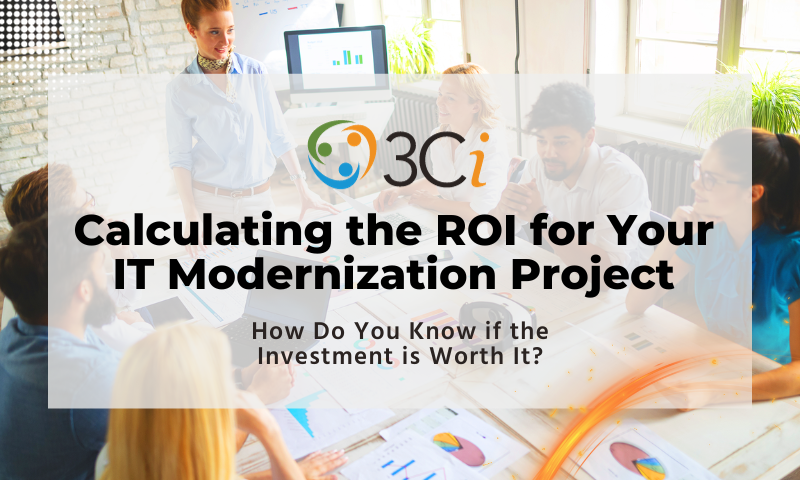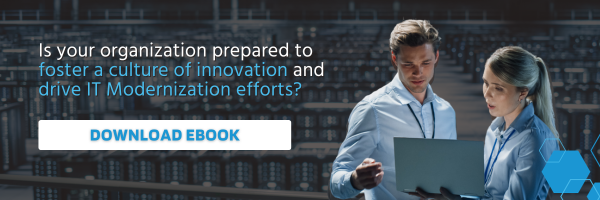Making the decision to invest in your IT infrastructure is a big one, but it’s one that can reap substantial rewards when done correctly. Completing an IT modernization project can bring a myriad of benefits to your company, from increased productivity to better communication and collaboration.
But, how do you know if the investment is worth it?
Here are some key steps to calculating and managing your business’s ROI during your IT Modernization project.
1. Define the purpose of your IT Modernization project
Any IT modernization project must have a clearly defined purpose in order to be successful. In essence, the goal is to achieve some form of improvement in the organization’s technological infrastructure. This might involve upgrading hardware and software, creating new applications, improving network connections, or simply making certain processes more efficient.
Whatever the specifics, the ultimate aim is to optimize the company’s operations, increase productivity, and stay ahead of the curve in an ever-changing digital landscape. By taking a strategic approach to IT modernization, organizations can achieve real, measurable benefits that have a positive impact on their bottom line.
2. Calculate the direct and indirect costs associated with modernizing your IT infrastructure
Direct costs may include expenses for purchasing new hardware and software, as well as costs for training employees on new technologies. For example, investing in state-of-the-art servers, networking equipment, and enterprise software can significantly enhance performance and productivity. Additionally, providing comprehensive training programs to employees ensures a smooth transition and maximizes the benefits of the upgraded infrastructure.
On the other hand, indirect costs can be harder to measure but shouldn’t be overlooked. These costs may include factors such as lost productivity during the transition period and potential downtime if systems are not properly integrated. For instance, during the implementation phase, there might be a learning curve as employees adapt to new tools and processes, leading to a temporary decrease in productivity. Moreover, if the systems are not properly integrated, there is a risk of experiencing downtime, which can result in financial losses and customer dissatisfaction.
By carefully considering both the direct and indirect costs, businesses can create a comprehensive budget that ensures a successful and efficient modernization process.
3. Analyze how long it will take to realize a positive ROI from your IT modernization project
Investing in an IT modernization project can be a major undertaking for any business. While the benefits of upgrading outdated technology are clear, the timeline for realizing a positive ROI may be less obvious. The truth is, the length of time it takes to see a return on investment will depend largely on the specific project and the goals you have in mind.
Generally speaking, if your project is focused on reducing costs or improving efficiency, you may see a positive ROI sooner than if you are pursuing more strategic objectives like expanding your customer base. Regardless of your specific goals, it’s important to approach your IT modernization project with a long-term mindset and a commitment to ongoing evaluation and improvement.
4. Develop a strategy for monitoring progress so you can adjust as needed to maximize ROI
When it comes to achieving the maximum return on investment (ROI), regularly monitoring progress becomes even more crucial. It involves meticulous planning, establishing clear benchmarks, and implementing a reliable system for tracking data.
To effectively monitor the progress of your IT modernization project, consider employing strategies such as using project management software, scheduling regular check-ins, creating a visual dashboard, setting up automatic alerts, and soliciting feedback. Consistency and communication are key to successful monitoring, allowing you to identify opportunities for improvement and maximize your project’s ROI.
This ensures that you are always up to date on how your business is performing and allows you to make informed decisions. By consistently monitoring progress, you can quickly identify any potential issues or bottlenecks and adjust your approach accordingly, thus maximizing your return on investment.
Investing in an IT modernization project comes with both risks and rewards, but when done effectively, it can lead to significant levels of increased efficiency, cost savings, and improved customer service. Through business analysis, careful budgeting, and a well-thought-out strategy for monitoring progress, any organization can maximize the positive return on investment from its IT modernization initiative.
If you are looking to stay ahead of the competition by modernizing your IT infrastructure, take the time now to define the purpose of your project, calculate costs and ROI potential, identify metrics for evaluation purposes, and develop a strategy that will help you stay on track for success. By taking these steps now, you’ll be better positioned to reap the benefits this type of transformation can bring.
To make sure your business thrives, it’s crucial to proactively plan for the future. Check out “Understanding IT Modernization: A Guide for Enterprises” to dig into the impact of IT Modernization on business.


